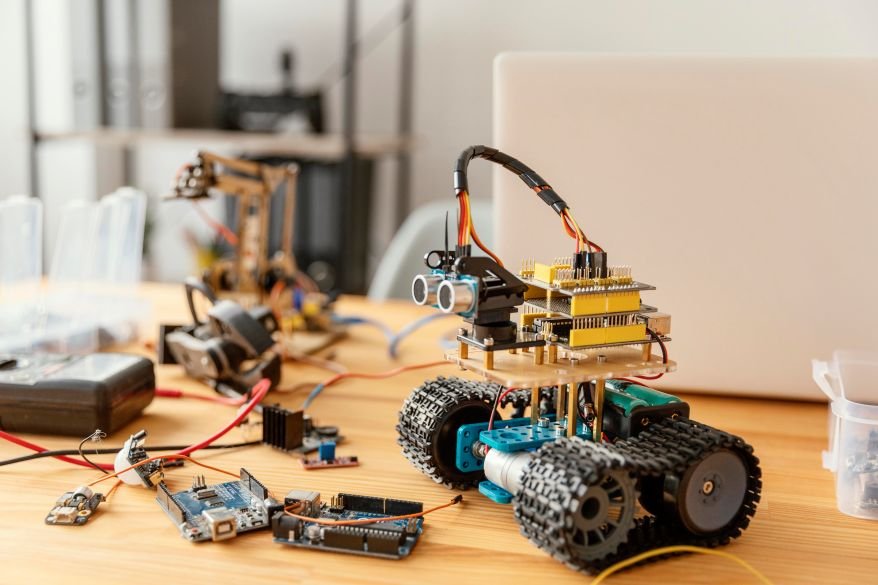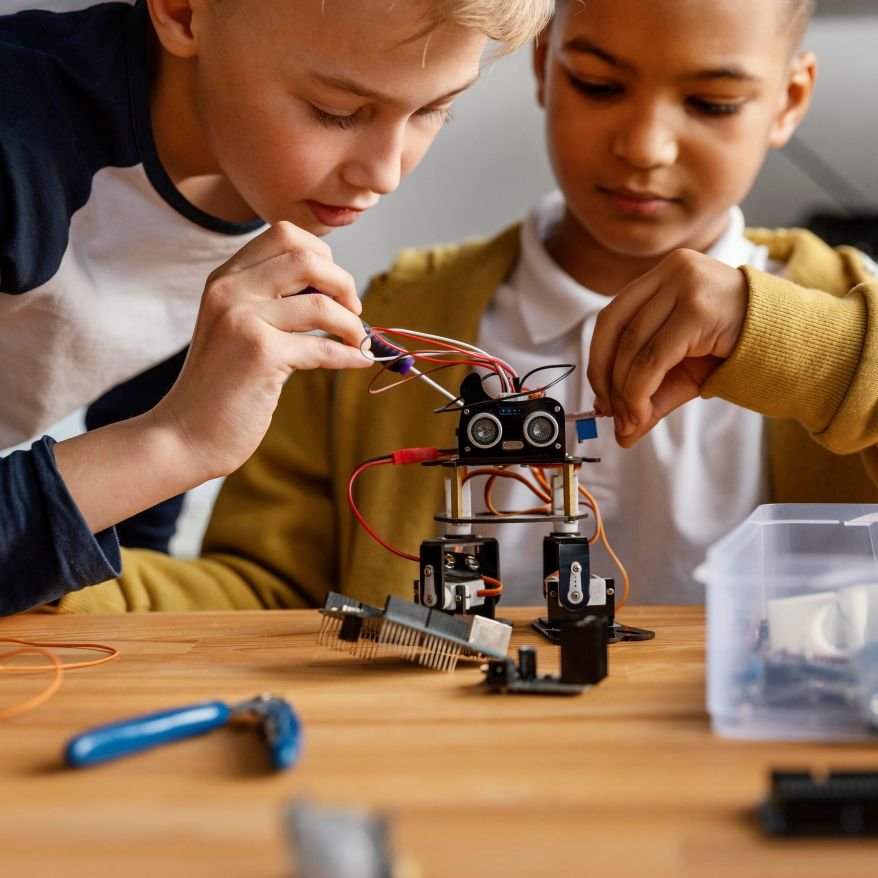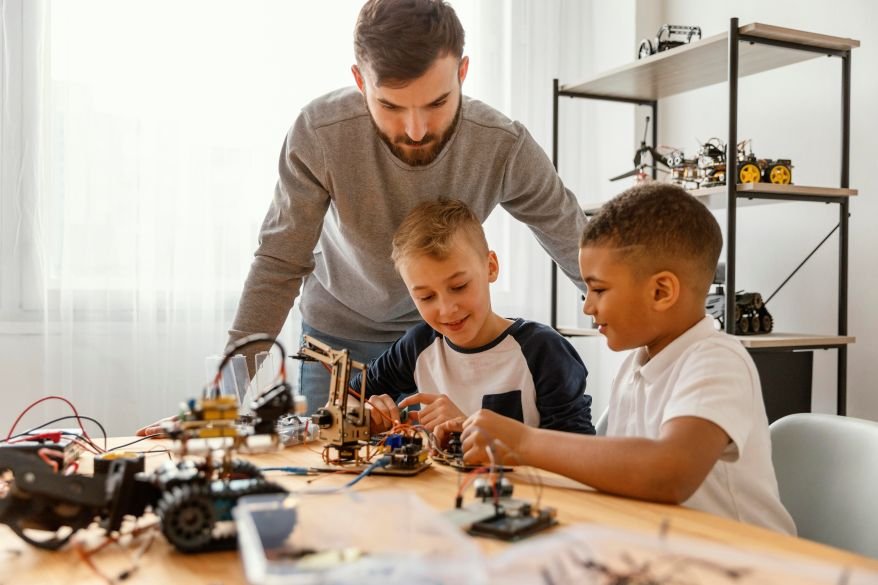Robotics in education is becoming increasingly popular in schools everywhere, especially through STEM. Moreover, a recent study shows growing interest, with 48 new studies in 2024—more than last year. For instance, teachers use robotics to connect science, technology, engineering, and math through hands-on activities. Additionally, robotics in STEM education challenges students, sparking curiosity and building coding, problem-solving, and teamwork skills. In fact, studies show robotics makes students more excited and engaged, making learning real and meaningful. Albert Einstein said, “Education is not the learning of facts, but the training of the mind to think.” Ultimately, exploring robotics in STEM education prepares students for a future filled with technology. Consequently, these experiences nurture innovative thinkers, problem solvers, and collaborative leaders who can thrive in a rapidly changing world.
STEM Robotics Integration

Hands-On Learning
STEM robotics lets students learn by doing activities. Furthermore, students use educational robots as tools in class. As a result, this helps them understand hard ideas in science and math. In addition, robots make tough concepts easy to see and fun to learn. For example, Bee-Bot and LEGO MINDSTORMS let students program robots and solve problems. Thus, this way, students practice logical thinking and learn computational skills early.
“Tell me and I forget. Teach me and I remember. Involve me and I learn.” — Benjamin Franklin
The table below lists some hands-on robotics activities and what students gain:
| Hands-on Robotics Activities | Description | Observed Outcomes |
|---|---|---|
| Robotics Elective Courses | Classes use robotics kits and are guided by teachers. | Students get more interested and learn more about STEM. |
| After-school Robotics Programs | Students build and test robots, sometimes in contests. | More students like STEM, especially those not often included; they think about STEM jobs. |
| Robotics Contests | Students solve real problems and show their robot ideas. | Students feel proud, see STEM as useful, and use business skills. |
| Teacher Professional Development | Teachers join workshops to learn about robotics. | Teachers get better at teaching robotics and students do better. |
Learning by doing in robotics makes students want to learn more. It also makes STEM easier to understand. Students remember more when they work on projects. They also learn teamwork, how to talk with others, and how to be creative.
Interdisciplinary Approach
STEM robotics links different school subjects together. For example, students use math to figure out distances. Additionally, they use science to learn about movement. At the same time, they use engineering to build things and technology to program robots. As a result, robotics shows how all STEM subjects connect in real life.
Robotics in school supports project-based learning. In fact, students work on tasks that need knowledge from many subjects. For example, a project might ask students to make a robot that sorts colors. Furthermore, they use math to measure, science to test, and coding to control the robot. Therefore, this helps students do better on tests that cover many subjects and get ready for real-world problems.
“The important thing is not to stop questioning. Curiosity has its own reason for existing.” — Albert Einstein
Robotics also helps teachers by giving them tools and training. Consequently, this helps teachers guide students through projects that use many subjects. Moreover, good teacher training is important for robotics to work well in class.
Real-World Application

STEM robotics lets students solve real problems. For example, in class, students use robots to learn about health, farming, and the environment. Specifically, they might program a robot to clean up plastic or plant seeds in a garden. Thus, these activities help students see how STEM knowledge applies to real-world issues, making learning both meaningful and impactful.
Here are some real problems students work on with robotics:
- Healthcare: Students learn about robots that help doctors do surgery.
- Sustainable Agriculture: Robots help plant and pick crops, making food production better.
- Manufacturing: Students program robots to do jobs, getting ready for future work.
- Environmental Conservation: Robots clean oceans and watch animals.
- Space Exploration: Students program robots for space missions like Mars.
Robotics education uses kits like LEGO MINDSTORMS, VEX Robotics, and Arduino robots. These kits make programming and building robots possible for everyone. Students also join robotics contests like RoboCup Junior and First Robotics Competition. These contests help students be creative and work as a team.
Project-based learning and robotics help students see how lessons connect to real life. This builds important skills for the future and helps students get ready for STEM jobs.
“Education is the most powerful weapon which you can use to change the world.” — Nelson Mandela
Adding robotics to STEM classes shows how learning by doing helps. Students feel more confident, curious, and proud when they solve problems and invent things. Exploring robotics through STEM helps students become leaders and creators in a world full of technology.
Student Benefits in Robotics Education

Critical Thinking Skills
Robotics education helps students get better at thinking and solving problems. For example, when students use robots like Bee-Bots and Cubelets, they plan steps and fix mistakes. Consequently, they see how actions lead to results. Moreover, these activities help students try new ways to solve problems. Research shows students who use robots get better at sequencing and debugging. In addition, they also learn logical and abstract thinking. As a result, students think about their choices and learn from them. As Albert Einstein said, “Education is not the learning of facts, but the training of the mind to think.” Therefore, robotics education lets students practice these skills in real life. Ultimately, this makes them better thinkers and problem solvers.
- Over 30 studies show that using robots helps students think better.
- Students who enjoy robotics activities grow most in problem-solving.
- Teachers say robotics helps students think and solve problems better than expected.
Engagement and Motivation
Robotics education makes learning fun and interesting for students. Many students say building and programming robots feels like playing. Consequently, this playful way keeps students focused and excited to learn. Moreover, tests show students improve memory, reasoning, and focus with robotics. Additionally, parents see their children get better at logical thinking and talking after robotics projects. As a result, hands-on robotics helps students pay attention and not get distracted. This positive experience encourages all students to want to join STEM education, making it more inclusive and appealing for everyone.
“Tell me and I forget. Teach me and I remember. Involve me and I learn.” — Benjamin Franklin
Collaboration and Communication
Robotics education teaches students to work together and share ideas. For example, group robot projects help students solve problems as a team. Moreover, each student has special skills, and together they find good answers. In addition, educational robots can help students talk and work together. Furthermore, telepresence robots help students feel close, even if they are far away. As a result, working in teams builds talking and leadership skills for the future. Consequently, these teamwork times help students become confident and flexible leaders
“Alone we can do so little; together we can do so much.” — Helen Keller
Exploring Robotics Through STEM for Future Readiness
21st-Century Skills
STEM robotics helps students learn important 21st-century skills. These skills are problem-solving, creativity, and teamwork. Students also learn to think in new ways. They learn how to manage projects. When students use robots, they practice leadership and talking with others. They get better at working with people and adapting to changes. Teachers notice students become more confident and aware of others. By using robotics for real problems, students learn to design, build, and improve their ideas.
“The only way to discover the limits of the possible is to go beyond them into the impossible.” — Arthur C. Clarke
Key skills students gain from stem robotics:
- Problem-solving and critical thinking
- Creativity and new w”The only way to discover the limits of the possible is to go beyond them into the impossible.” — Arthur C. Clarkeays of thinking
- Working together as a team
- Leadership and managing projects
- Adapting and understanding others
Career Preparation
STEM robotics gets students ready for jobs with cutting-edge technology. Students learn both technical and people skills. They practice coding, engineering, and looking at data. They also learn to work in groups and solve problems. These skills help students get ready for jobs in stem robotics and technology.
| Skill Type | Examples | Workforce Relevance |
|---|---|---|
| Hard Skills | Coding (block-based, Python), Engineering | Needed for technical tasks and designing solutions in STEM careers |
| Soft Skills | Adaptability, Creativity, Collaboration | Important for teamwork, innovation, and handling new technology in the workplace |
Many companies want workers who can think, change, and work well with others. Stem robotics helps students build these skills. Students in robotics programs often want STEM jobs. Some even work with space robots. By bridging the gap between stem education and workforce needs, robotics gives students what they need to do well.
Innovation and Creativity
Exploring robotics through STEM helps students be creative. For example, students design and build robots for science, math, art, and social studies. In addition, they use different shapes, colors, and features to show ideas. Moreover, robotics contests like FIRST LEGO League and VEX Robotics Competition ask students to solve real problems in new ways. Furthermore, virtual robotics lets students try ideas safely and learn at their own speed.
- Students show their ideas by making robots unique.
- Robotics makes students find new answers to problems.
- Contests and group work help teamwork and creative thinking.
- Fixing and changing robots teaches students to keep trying.
“Creativity is intelligence having fun.” — Albert Einstein
The future of stem robotics needs students who can create and work together. By learning with robots, students get ready for a world with lots of technology and new problems.
Overcoming Challenges in STEM Education
Access and Resources
Many schools have trouble adding robotics to classes. For instance, robotics kits and technology cost a lot. As a result, some schools do not have enough money for these things. In addition, some students do not have computers or internet at home. Therefore, this makes it hard for everyone to join robotics activities. To address this, RSE Academy uses cheap inventor kits and free software to help more students join. Moreover, they use both online and in-person classes. Also schools save money by using low-cost parts like servos and microcontrollers. For example, in Colombia, the Magician Lite program gave over 300 robots to faraway schools. Consequently, this helped more than 65,000 students learn robotics and get new technology. Finally, flexible lessons and tools let schools change robotics classes to fit their needs.
“Education is the most powerful weapon which you can use to change the world.” — Nelson Mandela
Teacher Support
Teachers need help to teach robotics well. Many teachers feel worried about coding and robotics. They did not learn these skills before. Good training programs help teachers feel sure of themselves. In San Diego, two teachers with little STEM experience got hands-on training with STEM kits and coding robots. After training, they led a STEM summer camp and added robotics to their classes. Live training, updates, and lesson guides help teachers get ready. Teacher training gives teachers the skills to use robotics in class. It also helps them keep up with new technology. When teachers feel ready, students learn more and enjoy robotics.
“A good teacher can inspire hope, ignite the imagination, and instill a love of learning.” — Brad Henry
Curriculum Alignment
Schools must make robotics lessons match state and national standards. This is called curriculum integration. Programs like “Growing with KIBO” show how to match robotics with CSTA K12, ISTE, and state standards. The 4-H STEM curriculum in North Carolina uses Lego Spike Prime and block coding to meet science standards. Teachers get special training to use these lessons. This makes sure lessons fit with stem education plans. Robotics contests and STEM academies help students reach learning goals. When schools use curriculum integration, students get lessons that match what they need for the future.
“The function of education is to teach one to think intensively and to think critically.” — Martin Luther King Jr.
Robotics in STEM education helps students learn in new ways and get ready for the future. Students build problem-solving, teamwork, and creativity skills by doing projects and joining contests. Research shows robotics helps students learn more, stay interested, and get ready for what comes next.
“Education is the passport to the future, for tomorrow belongs to those who prepare for it today.” — Malcolm X
Teachers and school leaders should help robotics by finding money, giving teachers training, and working with the community. Look for robotics tools, join groups that support robotics, and help make robotics important in every school. The future of STEM looks bright as students become creative thinkers and leaders.
References
- Tselegkaridis, S., & Sapounidis, T. (2022). Exploring the Features of Educational Robotics and STEM Research in Primary Education: A Systematic Literature Review. MDPI AG. https://doi.org/10.3390/educsci12050305
- Redfors, A., Greca Dufranc, I. M., García Terceño, E. M., Fridberg, M., & Cronquist, B. (2020). Robotics and Early-years STEM Education: The botSTEM Framework and Activities. Lectito Publications. https://doi.org/10.20897/ejsteme/7948
- Nikolaos Drakatos, & Sotiris Stavridis. (2023). The perspective of STEM education through the usage of Robotics. GSC Online Press. https://doi.org/10.30574/wjarr.2023.18.3.1146
